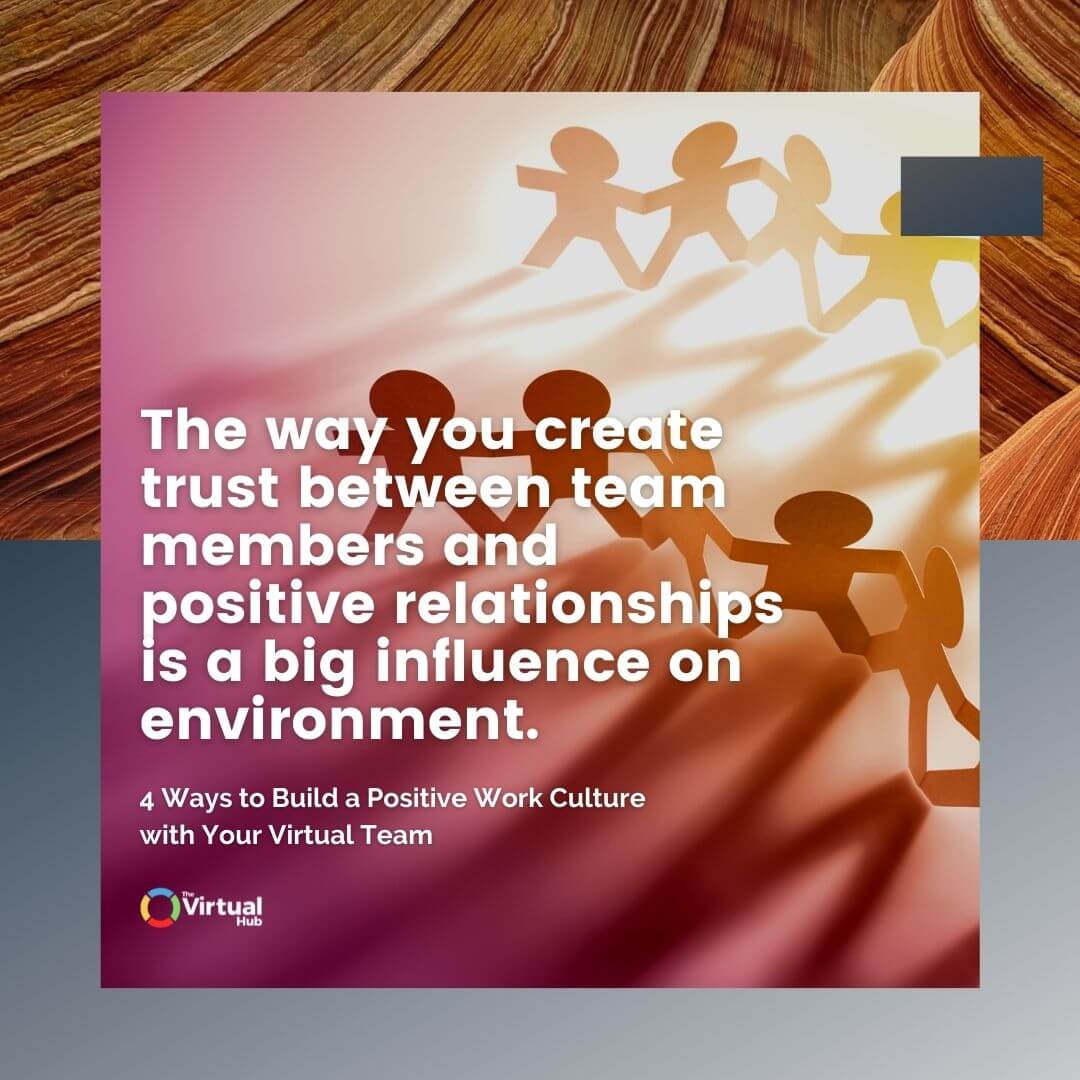Your company culture helps to shape everything about your business. It dictates the experience of your customers and the attitudes and beliefs of your team members. It's what drives your company forward and can be a huge factor in your organizational development and overall business success!
However, when your company is remote-based, it can present extra challenges when it comes to building and maintaining the company culture that you’d like. A virtual team doesn’t have the same opportunities for quick chats or informal banter as those who are co-located. You have to be quite intentional about creating the culture you want.
So, what can you do to build a strong company culture? Here are some strategies.
RELATED: Delivering Effective Constructive Feedback To Your Virtual Assistant
Creating a Positive Company Culture with Your Virtual Team
You can click on these links below to jump on a specific topic:
What Is Company Culture?
When you consider company culture, many ideas probably come up. In fact, culture means different things to each different team!
“Culture” has become a sort of buzzword among workplaces in recent years. You just have to look at popular Silicon Valley companies to see this played out.
Team culture has become synonymous with things like catered lunches and break room foosball. On the darker side, it can also lead to homogenous thinking and expectations of having “no life.”
The thing is that culture is much more than break rooms and team outings--those things tend to be nice distractions, or supporting tools in the overall culture. Remote teams can often struggle with this concept because you can’t do most of those things anyway! Culture is about how we work, how we communicate with customers and each other, and how we incorporate company core values into what we do.

Virtual teams potentially have to work harder than those who are co-located to create a cohesive team culture. While you can also avoid some of the more toxic examples of co-located workplace culture, you need to work hard to ensure people work as a team, rather than individual units.
What Is a Positive Company Culture?
A positive corporate culture can be defined as a workplace where remote employees are engaged and satisfied with their jobs. This type of work environment is characterized by a diverse community with open communication and mutual respect.
Remote workers in a positive remote culture feel like they are part of something larger than themselves and are motivated to do their best. Additionally, engaged workforce are more likely to stay with the company for longer periods of time.
Creating a positive work culture is essential for any organization that wants to attract and retain top talent.
In today's competitive marketplace, employee engagement and employee satisfaction are more important than ever. By fostering a positive remote work culture, companies can set themselves apart from the competition, and build a strong foundation for long-term success.

What Are the Strategies for Creating a Positive Organizational Culture and Promoting Teamwork Online?
Culture Begins with Leadership
Have you ever thought about your management style? The way you lead has the biggest impact on your overall workplace culture. In a remote environment, you’re relying on people to take ownership and have a certain level of independence - it’s not like you can look over their shoulder!
In an article for Forbes, Jim Mullaney, CEO & Founder, Edoc Service, Inc. talks about how the old “command and control” style of leadership just isn’t conducive with a remote team environment:

“That whole ‘I’ve got to see you working or I won’t get my money’s worth’ attitude doesn’t work,” says Jim. Instead, he recruits self-managing professionals who are aligned and engaged with the company’s purpose. He considers himself a steward, not an owner. To him, that means taking care of the resources that he’s been given, and making sure that they serve the staff and the clients for overall success. “For the virtual model to work, that’s the mindset you have to have,” says Jim.
For this to work well, it helps to know where you want to be first. If you haven’t already, defining the company's mission, core values, and organization's long term objectives can be a great starting point. You can then attract elite candidates who meet those values.

Consider What Makes a Positive Work Environment
The environment you build is a big contributor to having a positive workplace culture. In fact, you could say that environment is the embodiment of your culture at work. The way you create trust and foster meaningful relationships among your team members is a big influence on environment.
Again, you can lead from the front when it comes to creating the right environment and building trust. On the whole, people do tend to want to do good work - those who are given trust often reward you by reciprocating and doing what it takes to earn that trust too.
Jim Mullaney talks about another aspect of the remote team environment - it must be set up so that a win for one is a win for all:
Instead of a team environment, many companies have a sales environment. “Salespeople are often competing with one another, and they’re not interested in other members winning. It’s all about themselves,” says Jim. “In a team environment, a win for the team means that everyone has to win, and everyone wants to help one another win.”
Part of the environment can be the rituals or traditions that your team observes. When you think about it, groups of people who are close often have certain traditions they follow which helps to bring them close together. You can create these rituals in a remote environment as well.
For example, perhaps you celebrate as a team somehow when sales milestones are met, or even have “mini” celebrations for each achievement made.
Reward employees for their achievements. This could include financial bonuses, paid time off, or simply public recognition.
Encourage collaboration and creativity. Make them feel empowered, and make it clear that all voices are welcome and valued. Make sure everyone feels like they are part of the team. If someone is feeling left out, take measures to include them.
RELATED: Balancing Workload And Preventing Virtual Assistant Exhaustion

Value Communication
Communication--what we say and how we transmit the message--can have a massive impact on whether or not you have a positive workplace culture.
Is employee's feedback encouraged? When and how is it delivered? What channels do team members have for communicating with one another? Do employees feel heard?
There can be a tendency in a remote environment for owners or managers to go very hands-off, especially when many employees are up-to-speed. This can be a problem when the only time you’re checking in is to deliver negative feedback, or to hand off some kind of unpleasant task. You could become like the old “seagull manager,” the one who swoops in, dumps a pile of poop, then wings its way off again.

The danger of this is that sometimes, disengaged employees start to feel that they’re not really valued. A positive workplace culture hinges on how people feel valued, and value their work in return. People need to be acknowledged when they’ve done something great, as well as when they need to improve.
Among team members, that communication is vital to build a sense of belonging and teamwork.
There are a number of potential ways to accomplish this remotely. For example, some businesses use communication tools like Slack, and set up an active “water cooler” channel in it. You can get the ball rolling by asking “icebreaker” type questions that get team members talking about themselves.
Another example is to have a virtual monthly town hall meeting. Encourage employees to actively contribute ideas, get feedback, and help them to connect with one another and with you, as their business leader.
Alternatively, you may set up communication channels that offer a secure and private way for each employee individually to share ideas, thoughts, and feelings without judgement.
Additionally, in today's workplace, it's more important than ever to promote inclusive language. Whether you're communicating with co-workers, clients, or customers, using language that everyone can understand and relate to is essential.
By promoting inclusive communication, you can create a positive environment where everyone feels valued and respected.

Here are some culture initiatives that can promote inclusive communication in your workplace:
Use simple, clear language that everyone can understand.
Avoid jargon and acronyms that not everyone may be familiar with.
Be aware of the connotations of the words you use. For example, words that are traditionally associated with men or women can exclude members of the opposite gender.
Avoid making assumptions about people's background or knowledge level. Instead, explain things clearly and concisely.
When in doubt, ask people how they prefer to be addressed. For example, some people may prefer to use their initials instead of their full name or they may have a preferred pronoun (he/she/they).
Keep in mind that good communication can help to increase productivity and morale, as well as create improved employee relationships. It can also help to resolve conflicts and avoid misunderstandings.
Value Openness and Accountability
Following right along from how you communicate is how much you value openness and accountability among your team.
Effective virtual teams have members who understand exactly where their individual work fits into the scheme of organization's goals and strategy.
Understanding what dependencies exist on their work and how it is connected with everyone else’s helps to create a sense of ownership and accountability.
An open environment, encouraging of honesty and respectfully offering opinions, also adds to a positive culture. Allowing everyone to have a voice helps to add to their feeling of being valued and belonging, while potentially giving you different viewpoints to explore.

Final Thoughts
There are aspects to building a positive work culture that are definitely much more challenging as a remote team. Physical distance can create emotional distance as well, which is something you need to put strategies in place to avoid.
Successful remote teams tend to have a strong leader who demonstrates exactly what they expect to see in the company. You want team effort? You display teamwork yourself and provide the appropriate channels and policies to facilitate it.
A positive work culture flows through to everything you do in your business, including your overall organization's success. Remember, a culture will develop anyway in every business, so being intentional from the start is one of the best ways to move forward.
Up Next:
